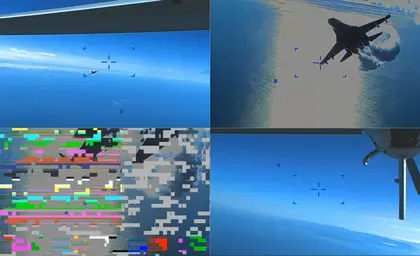As the political fallout and blame game sparked by the collision between a U.S. drone and a Russian fighter jet continues, Washington has released a video of what it described as the “unsafe” and “unprofessional” intercept.
Remind me, what happened?
JOIN US ON TELEGRAM
Follow our coverage of the war on the @Kyivpost_official.
Earlier this week, a U.S. spy drone was forced to crash into the Black Sea after a Russian fighter jet dumped fuel on the unmanned aircraft and then collided with it.
Well, that was the U.S. version of events: Moscow caused the crash of the drone.
Whereas the Russian Defense Ministry said: “As a result of a sharp maneuver... the MQ-9 unmanned aerial vehicle entered an uncontrolled flight with loss of altitude and collided with the surface of the water,” adding that the two Russian jets had no contact with the U.S. aircraft and did not use their weapons.
What does the new video show?
The declassified 42-second video – which the U.S. military says has been edited for length – shows a Su-27 jet bearing down on the propeller-driven MQ-9, releasing streams of fuel as it passes in an apparent effort to harass the drone.
Official footage released by the U.S. Air Force of the collision between a Russian Su-27 and US MQ-9 over the Black Sea. pic.twitter.com/kZaYUyXzVm
— OSINTtechnical (@Osinttechnical) March 16, 2023
An Su-27 makes another pass, again dumping fuel. The video is then interrupted – a cut the U.S. military said lasts for 60 seconds as a result of a Russian jet striking the drone.
When the feed returns, part of the drone’s propeller is missing.
Is the video genuine?

N. Korean Troops Massed in Russia to Enter Ukraine War ’Soon’: Pentagon Chief
It appears to be and some OSINT sleuths have tentatively geo-located the footage to the skies above the Black Sea.
What does the U.S. say the video proves?
General Mark Milley, the Chairman of the U.S. Joint Chiefs of Staff, said on Wednesday that it was unclear whether the collision was done on purpose, though the “aggressive behavior” was intentional.
What’s the bigger picture?
The incident has ratcheted up tensions between Moscow and Western allies, already soaring over Russia’s invasion of Ukraine, but top security officials from the U.S. and Russia have been in touch.
U.S. Defense Secretary Lloyd Austin spoke with his Russian counterpart Sergei Shoigu on Wednesday, the Pentagon said, while Moscow’s Defense Ministry said General Staff Valery Gerasimov had spoken to General Milley.
“We take any potential for escalation very seriously and that’s why I believe it’s important to keep the lines of communication open,” Austin said after his call with Shoigu.
“I think it’s really key that we’re able to pick up the phone and engage each other. And I think that will help to prevent miscalculation going forward.”
What happens now?
Russia plans to try to retrieve the downed craft but was unsure if the effort would be a success. Milley said the drone likely broke up and sank in an area where the water is 4,000-5,000 feet (1,200-1,500 meters) deep.
Even if Russia was able to recover the wreckage, the U.S. took “mitigating measures” to protect sensitive information and is “confident that whatever was of value is no longer of value,” he said.
The United States uses MQ-9s for both surveillance and strikes and has long operated over the Black Sea, keeping an eye on Russian naval forces.
Several of the drones have been lost in recent years, including one that the U.S. Central Command said was shot down over Yemen with a surface-to-air missile in 2019.
You can also highlight the text and press Ctrl + Enter






